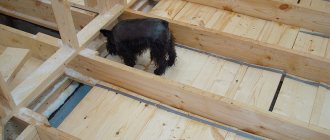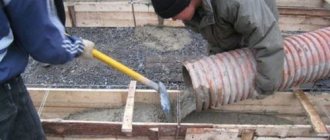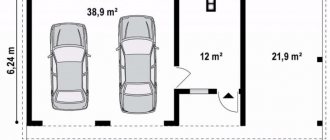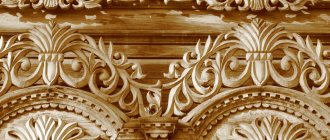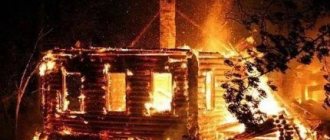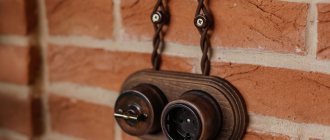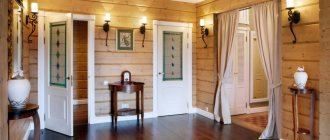The construction of wooden residential buildings and other objects has not lost its relevance today. Building codes and regulations strictly regulate technological processes, paying special attention to electrical installation work. Changes are constantly taking place in this area, new materials and equipment are being used, including socket boxes for a wooden house. And although hidden wiring in wooden houses is installed quite rarely, these installation boxes are in demand, as they fully ensure electrical and fire safety.
Features and key requirements for wiring in a wooden house
Based on many years of experience of specialists, the features and requirements for electrical supply include the following requirements:
- In the event that a short circuit occurs, the project must take into account and prevent the occurrence of ignition of the wiring, or minimize this possibility in order to prevent the fire from spreading to the wooden walls of the building;
The possibility of contact between wires and wooden walls should be excluded Source rinnipool.ru
- Wires used for wiring electrical networks must have a safety margin necessary to withstand extreme loads. Also, the possibility of heating the connections and cables themselves should be eliminated;
- The laying of the electrical supply must comply with safety standards to prevent even accidental human contact with live lines.
When drawing up a wiring project for a wooden house, it is necessary to consider the safety and reliability of the structure, and only then design and other decisions.
What do you need to know about cable cross-section?
This parameter is determined based on the current strength. If the cross-section and loads do not match each other, short circuits will occur, resulting in a fire. So, if the plans include closed wiring, and the estimated current is 16 A, a cable with a minimum cross-section of 2 mm² is required. With a rated current of 25 A - 4 mm².
Select cables according to distribution groups and depending on the expected load. In order to connect the sockets, you will need a cable with copper conductors with a cross-section of 2.5 mm². The maximum total power is 4.6 kW.
Lighting devices are powered by a cable with a cross section of 1.5 mm². The power of this group is up to 3.3 kW. Therefore, the number and location of light sources must be planned before installation begins - when drawing up an electrical circuit
High-power home equipment is connected with a cable having a cross-section of 4 mm². Such devices must be connected to an individual outlet and cannot be connected to another group.
What is unacceptable when installing wiring in a wooden house
Unskilled work with electrical wiring jeopardizes not only the integrity of a wooden house, but also the lives of its inhabitants.
The most common mistake is to carry out hidden wiring, followed by laying it on wooden bases, in floor voids, under baseboards, as well as ceiling and wall cladding.
Under no circumstances should you carry out hidden installation of electrical wiring using a plastic box and pipes.
A short circuit can result in more than just charring of the wires Source innotechnews.com
Over time, the insulation of the wires receives microdamage due to temperature changes, changes in air humidity and deformation. Subsequently, exposed sections of parallel conductors can cause a short circuit, which will lead to a fire, and if it occurs under the casing, extinguishing with traditional means will be useless.
Using log overlays
Decorative overlay for a rosette on a log
Through drilling through solid wood is a very difficult and expensive process that is simply impossible to do on your own. This requires special equipment and skills to make precise horizontal and vertical channels over long distances. It is much easier to take the path of less resistance using the technology of laying electrical wiring in walls made of concrete and brick. We are talking about laying grooves in which a corrugated steel tube will be laid.
The problem is that the channels cannot be sealed with putty or mastic. For this purpose, special plastic linings are used that reliably imitate natural wood. To reduce the amount of work, the cable is laid under skirting boards and platbands. Finally, one horizontal groove is made, which, after securing the cable in it, is covered with a cover plate. A hole in the shape of a glass is made in the cover itself. After installing the socket housing, it is closed with a lid.
The sequence of stages of work on installing wiring in a wooden house
A safe and correct sequence for installing wiring and electrical equipment in a wooden house consists of the following steps:
- Creation of a power supply wiring project, taking into account the peak load of all building equipment;
- Selection of the necessary wiring, power units powered by electricity, as well as the fastening system (taking into account the calculated maximum load);
- Installation activities aimed at connecting the network to the distribution board, and installing additional equipment (meter, switches); Wiring of cables and wires in accordance with the approved project;
- Installation of sockets, light sources, switches and other necessary equipment;
- Installation and connection of grounding, as well as residual current devices;
Without good grounding you cannot protect your house from troubles Source strojdvor.ru
- Carrying out control testing of electrical wiring.
Creating a wiring project in a wooden house must be carried out in strict accordance with the set of rules for electrical installations. When selecting and marking the wiring route, it is necessary to avoid a large number of bends and turns.
If the building has characteristic architectural features or there are any obstacles on the walls, which causes difficulties when pulling wires, in such places the installation of specialized distribution boxes made of metal (steel/copper) is required. The number of such soldering cups must be optimal, since any excessive connection, made in compliance with all norms and rules, introduces elements of weakening and unreliability into the electrical circuit, which in turn has a detrimental effect on safety.
Important! It is prohibited to cover distribution boxes with any decorative elements that make it difficult to access them for measuring, maintenance and control.
The distribution box must be in an accessible place Source karkasdomproekt.ru
See also: Catalog of companies that specialize in electrical work.
The installation of such junction boxes must be carried out in compliance with the following standards and regulations:
- The load-bearing characteristics, as well as the strength of the walls and ceilings of a wooden house should not be compromised when choosing the installation depth of the pipes through which the cables will be pulled. The number and location of bends, distribution boxes and other components are calculated in such a way that, if necessary, without any problems, it is possible to replace part of the wire, avoiding the need to damage and disassemble the wooden elements of the house;
- The choice of diameter and wall thickness of a metal pipe is made taking into account the characteristics of the wires, as well as their quantity. It is allowed to lay one or several cables in one liner, but in total they should not occupy more than 40% of the space inside the pipe. In this case, it is the outer thickness of the wire that is taken into account, including its insulating layer;
- The thickness of the walls of the liner is selected in accordance with the cross-section of the cable (its cores) passing through it during installation of wiring in wooden buildings.
Before pulling a wire through a pipe, it is necessary to measure the resistance of the insulating layer. This manipulation is performed to check the technical condition of the conductor and its compliance with the characteristics approved in the project.
Checking the insulation resistance of the wiring will reduce the likelihood of a fire Source bizlida.by
The inspection process helps determine the presence of damage to the insulating layer during all stages of arranging wiring in a wooden house.
To protect the cable from damaging the integrity of the insulation at the ends of pipes and ducts, pulling is accompanied by the use of specialized plastic attachments that are put on the end parts. At the end of this process, measuring work is carried out aimed at preventing the possible connection of a defective wire to the electrical network.
Cables that are used for wiring in a wooden house have a special marking. Their properties include protection against ignition at high temperatures.
Fire-resistant non-flammable wallpaper: fire protection technology
CATALOGS OF BASIC COATINGS (painting, PVC film, HPL plastic):
Catalog of acrylic wall panels
Catalog of wood-coated wall panels
Catalog of PVC coatings (lamination) of wall panels
Correct wiring, mounting of sockets and switches in a wooden house
There are many ways to do wiring, but only a few are correct. Before proceeding with the installation of wires, it is necessary to determine the route of its fastening, the future location of distribution boxes, sockets, light sources and switches.
Installing sockets in a wooden house with hidden wiring does not spoil the interior, but it has its own characteristics Source lv.grupoquepasa.com
Hidden wiring is carried out by laying cables in special pipes made of fire-resistant materials, and is carried out in the following order:
- Preparing the cable route and cutting grooves. Next, the distribution boxes are fixed (taking into account access to the wires after covering);
- Wiring through walls is carried out using special metal sleeves with plugs (a similar procedure is carried out for connecting sockets and switches);
- Selecting the material from which the pipes will be made (copper is considered the best option). Their ends are stripped to avoid damage to the insulating layer. Pipes are fixed to the walls using clamps;
- Pulling cables through pipes or special plastic channels, and conducting preliminary insulation testing;
- Then the wiring bundles are distributed and a margin of 20 cm is left. The cables are connected to each other and insulated with special caps;
- The wires are connected to all necessary places, in accordance with the color markings.
Wiring in a log house is fundamentally no different from work in a timber structure.
A socket in a wooden house may be wooden, but the basic requirements for its installation remain the same Source story-cklad.ru
Load distribution
To prevent overheating of the contacts and fire of the line, you should distribute the load as evenly as possible and distribute the wiring in the house. For the calculation, data obtained when the network was operating at design capacity for 20–30 minutes is used.
Group consumers according to the following principles:
- similar devices;
- summarized indicators;
- powerful devices with long operating time.
Place the installations along the lines, and upon completion of the calculations, select the number of directions, differential circuit breakers, RCDs, cross-section of cable cores and type of sockets for individual rooms.
Electrification of a wooden frame house is a complex process that requires compliance with numerous rules and recommendations prescribed in the PUE and joint venture. Without proper knowledge and experience, it is almost impossible to do it on your own. It is recommended to seek help from specialists, at least for consultation. Only competent installation of wiring and selection of high-quality materials guarantee the electrical and fire safety of the building.
Video description
For a clear overview of electrical wiring in a wooden house, watch the video:
A separate point of electrical installation work is the arrangement of grounding. Moreover, it is necessary to ground not only the sockets, but also the pipes through which the wires are laid. Therefore, it is so important to make a reliable connection at the junctions of the pipes and cups - they are often additionally connected with wires.
Grounding the electrical network is a prerequisite for ensuring fire safety - not a single new electrical wiring project that does not provide for grounding will be accepted by regulatory authorities.
All pipes must be grounded Source zgbox.ru
Soldering is the most reliable and high-quality option for connecting cups with supply pipes of all possible. This type of fastening provides safe, resistant to mechanical damage and anti-corrosion contact.
Flaring of the ends of the pipes that are in the cup is carried out if they are made of copper. When steel pipes are used, a nut connection is used. To do this, threads are cut at the ends of the pipes. The nuts are tightly tightened, fixed and treated with an anti-corrosion agent.
The protection class of the distribution cups must correspond to values not lower than IP-54, which ensures the prevention of any type of dust and water droplets from entering it.
ABS plastic
ABS plastic
(acrylonitrile butadiene styrene, chemical formula (C8H8)x·(C4H6)y·(C3H3N)z) is an impact-resistant technical thermoplastic resin based on a copolymer of acrylonitrile with butadiene and styrene (the name of the plastic is formed from the initial letters of the names of the monomers). Proportions can vary between 15-35% acrylonitrile, 5-30% butadiene and 40-60% styrene.
It can be recycled again. [1]
Some types of ABS can degrade when exposed to sunlight. This caused one of the most extensive and costly vehicle recalls in US history [2].
Content
Properties [edit | edit code ]
- Opaque (although there is also a transparent modification - MABS) material of a yellowish tint. Painted in various colors.
- Non-toxic under normal conditions
- Durability in the absence of direct sunlight and ultraviolet radiation [3]
- Resistance to alkalis and detergents
- Moisture resistance
- Oil resistance
- Acid resistance 103 °C (up to 113 °C for modified grades)
- Wide operating temperature range (−40 °C to +90 °C)
- Soluble in esters, ketones, 1,2-dichloroethane, acetone, ethyl acetate. [3]
- Density 1.02-1.06 g/cm³
Grounding and RCD
Household appliances are an integral part of any home. Electrical equipment most often has a completely or partially metal frame, which must be connected to ground.
Stages of installation work for grounding a wooden house:
- Initially, 3 metal rods are prepared, 3 meters in length and 3 centimeters in diameter. Next, a ditch is dug in the form of a triangle with equal sides 1 meter in length. The depth of the ditch depends on the level of soil freezing. Metal rods are placed in the corners of the dug trench;
This is what triangular grounding looks like Source kadetbrand.ru
- Then, using metal corners, the rods are connected to each other by welding;
- An eye is welded onto one of the corners, to which a steel rod with a diameter of 1 centimeter is attached, using welding or a screw-shaped connection;
- The rod must be positioned so that the grounding device, using a conductor, is connected to the electrical panel. The grounding cable has an insulating layer of yellow-green color.
To ensure safety in the event of an electricity leak on the metal casing of household appliances, a residual current device is installed. This device is installed directly in the switchboard and connected to the electrical network after the meter. The residual current device is configured in such a way that it reacts to the slightest current leakage. Such equipment must be installed in rooms with high air humidity.
Surge filters St. Petersburg
| Number of sockets: | 6 |
| Color: | white |
| Maximum current: | 16a |
| Cord length: | 3 m / 5 m / 1.9 m |
| Input plug: | euro |
from 490 to 920 ₽
20 offers
| Number of sockets: | 6 |
| Color: | white / black / gray |
| Maximum current: | 10a |
| Cord length: | 1.8 m |
| Input plug: | euro |
from 320 to 580 ₽
13 offers
| Number of sockets: | 6 |
| Color: | White black |
| Maximum current: | 10a |
| Cord length: | 3m |
| Input plug: | euro |
from 360 to 610 ₽
12 offers
| Number of sockets: | 5 |
| Color: | white |
| Maximum current: | 10 / 10a |
| Cord length: | 1.83 m |
| Input plug: | schuko cee 7/7p |
from 1,249 to 2 070 ₽
12 offers
| Number of sockets: | 5 / 4 |
| Color: | white |
| Maximum current: | 10 / 10a |
| Cord length: | 1.83 m |
| Input plug: | euro |
from 2,059 to 3 140 ₽
12 offers
| Number of sockets: | 6 |
| Color: | White black |
| Maximum current: | 10a |
| Cord length: | 5 m |
| Input plug: | euro |
from 410 to 660 ₽
10 offers
| Number of sockets: | 1 |
| Color: | white |
| Maximum current: | 16a |
| Cord length: | without cord |
| Input plug: | schuko cee 7/7p |
from 1,010 to 2 399 ₽
10 offers
| Number of sockets: | 6 |
| Color: | white |
| Maximum current: | 10a |
| Cord length: | 2 m |
| Input plug: | euro |
from 2 311 to 3 590 ₽
10 offers
| Number of sockets: | 5 |
| Color: | white |
| Maximum current: | 10a |
| Cord length: | 1.83 m |
| Input plug: | euro |
from 1,588 to 2 590 ₽
10 offers
| Number of sockets: | 1 |
| Color: | black |
| Maximum current: | 16 / 16a |
| Cord length: | without cord |
| Input plug: | schuko cee 7/7p |
from 1,049 to 1 760 ₽
7 offers
| Number of sockets: | 5 |
| Color: | white |
| Maximum current: | 10a |
| Cord length: | 10 m |
| Input plug: | euro |
Electrical wiring testing
Electrical wiring testing is performed using accurate, certified specialized equipment, and should be carried out exclusively by specialists who can correctly process the data generated by the devices.
Testing is a mandatory step before launching a home electrical network Source kvlservices.be
The process of conducting verification tests includes the following manipulations:
- Visual control;
- Measuring work to identify conductor insulation resistance;
- Preventive grounding measurements;
- Checking the functionality of the automatic shutdown system;
- Identification of the zero phase of the electrical network;
- Control testing of protective equipment;
- Detecting breaks in the wiring connection to the grounding device.
After completing all the necessary work, specialists issue a document that contains data on the testing performed. This operation is an important element of wiring in a log house, as it allows you to prevent damage to property and protect the occupants of the building.
